This free animal research project will provide you with a writing unit of study that will help you build excitement about writing informational text in your classroom.
You can download this free animal research project to help your writers develop their research and writing skills.
This project will be a great fit for your first, second or third grade writing workshop.
This is another free resource for teachers and homeschool families from The Curriculum Corner.
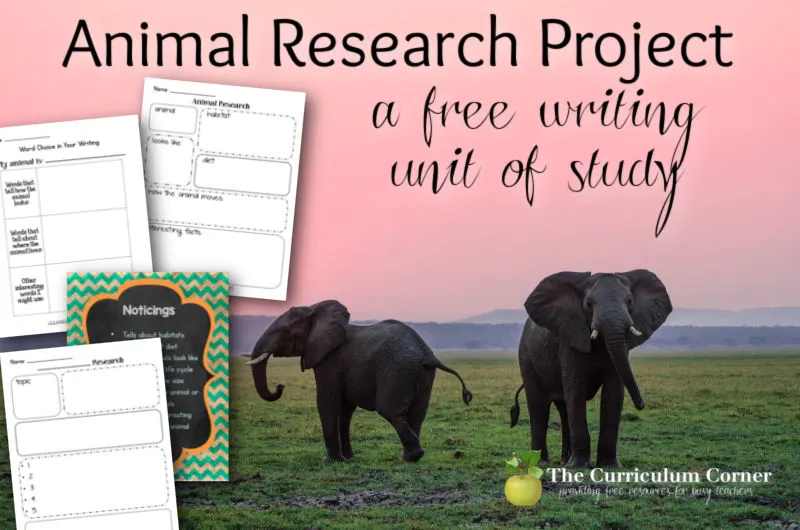
Why should I introduce my students to research through animal study?
Animal research can be a great topic for writing informational text because students tend to be curious about animals.
Nothing seems to spark interest in most kids like learning about animals in our world. Turn their enthusiasm into an engaging animal research writing project.
They can take the time to learn about different habitats and diets.
You can also encourage students to expand their vocabulary by having them create a glossary to accompany their writing.
About this animal research project
Within this post you will find over 30 pages of anchor charts, mini-lesson ideas, writing planners and graphic organizers.
The unit will help guide your students through the complete process. In the end, you will be helping to teach your students how to write their own pieces of informational text.
The intended end product for students is an animal booklet that they can staple together to share with others.
Students who are ready for more advanced work, can create a larger project with less direction.
A description of the mini-lessons
Lesson 1: Introduction
- Begin the unit by having the students brainstorm a list of animals that they might see everyday.
- Then, have them brainstorm a list of animals they see when they visit the zoo or walk in the forest. You can do this on the blank anchor chart provided or on cart paper.
- Another option is to place students in groups. They could work to create a list together.
- You might assign each group a continent and have them find animals that live there.
- Pull the class together and have each group share what animals they found that live on their continent.
Lesson 2: Noticings
- Next you might want to get your students familiar with common characteristics about informational texts that teach about animals.
- Have them work in pairs or small groups to go through some books and record their “noticings” about the writing.
- Then come together in a community circle to discuss those noticings and create a class anchor chart.
- For this lesson we have provided an anchor chart. You can use put the chart up in your classroom after the discussion. Or, work together to create your own noticings chart during your class discussion.
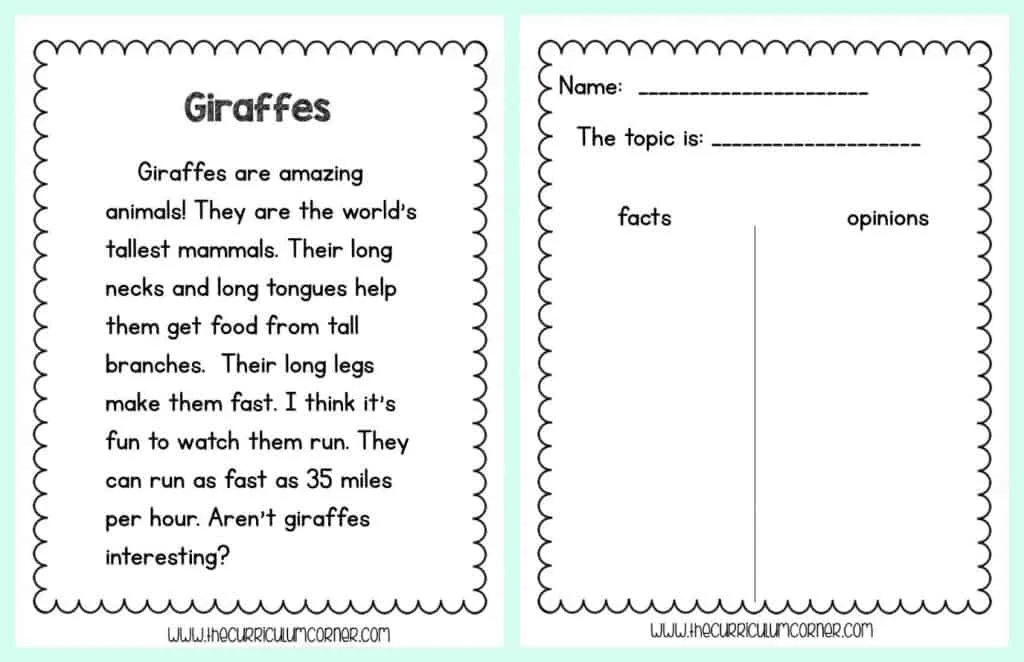
Lesson 3: Opinion vs. Facts
- Before getting truly into this unit, you might need to conduct a lesson on opinions vs. facts.
- After a brief discussion you can use the giraffe paragraph provided in our resources to give your students some practice differentiating between the two. This paragraph contains both opinions and facts.
- With your class read through the paragraph and record facts and opinions on the T-chart.
- Discuss both sides and how they are different from each other.
- A black & white copy of this giraffe paragraph has also been provided. You can have them work in pairs or groups to distinguish between the facts and opinions.
- If you need more resources for your students surrounding fact & opinion check out our Fact & Opinion Sort.
Lesson 4: Choosing a Topic for the Animal Research Project
- We want to help students to narrow their topic choices by giving them some guidance.
- Gather students and begin a discussion about choosing an animal research topic.
- For this lesson we have provided two pages where students can individually brainstorm the animals they are interested in.
- You might have students work in groups or independently to make their choice. Conference with students as needed to help.
- Don’t shy away from letting more than one student research about the same animal. This can be a great way to promote group work. It might also help out with some of your literacy center choices throughout this unit.
Lesson 5: Good Places to Find Information about an Animal
- At this age we want students to begin to understand that all they read online about animals isn’t always true. Sometimes writing might sound true without being filled with facts.
- Show students two possible places to find information online about their animal. One should be a trusted site with reliable and accurate information. Another should be a site that perhaps a child has created. (There are many that you can find if you search.)
- Pose these questions: Is everything on the internet true? Why? How can you tell? Why is it important for your research writing to contain accurate information?

Lesson 6: Taking Notes
- Sometimes giving students resources and a blank sheet of notebook paper can be too overwhelming for them. Some students will copy word for word. Others might feel overwhelmed. We need to guide them to read and pull out facts & relevant information to use later in their writing.
- For this lesson we have provided four templates for note-taking that you might choose to use for your students.
- You might need to provide different organizers to students depending on their needs.
- You will want to model the organizers your students are use. Show them how to take notes as they read.
- After initial teaching, you may find that you need to pull small groups for extra practice. Others might benefit from a conference as you take a look at the notes they are taking.
Lesson 7: Word Choice in Research Writing
- To help students think about making their writing more interesting, have them brainstorm words about their animal.
- Together brainstorm words that would be appropriate for animals. They might add words about what they look like, their movement, their habitats, their life cycles, their diets, etc. You can create a class anchor chart on the page provided. You might even think about using the real life picture of the wolf in the download. This can get the students to begin thinking of more interesting words for animals (fierce, mighty, strong, etc).
- Then, pass out the individual brainstorm pages. Students can use the anchor chart as a guide to begin their own word choice pages about their animal. This might be a good partner activity as well.
Lesson 8: Writing Sketch for the Animal Research Project
- Next, you can model the writing sketch planner for your class.
- One idea to help your students narrow down all of the information they have learned about their animals is to give them a specific number of animals facts that they can focus on.
- Each of these facts can serve as the actual text that they will put on each page of their animal research book. Or the facts could serve as a focus for each paragraph in their writing.
- You might find that this would be a good mini-lesson to do with smaller groups of children.
Lesson 9: Creating a Table of Contents
- Another idea that can be a writing planner AND a page in their animal research book is the table of contents. Pull out one of the Table of Contents pages from the resources provided and model how to fill in the blanks on each page.
- This page will then serve as their Table of Contents (with a focus discussion on what that is and the purpose it serves) and also their writing planner so they know what they will put in the pages of their booklet.
Lesson 10: Creating a Glossary
- There are two pages provided in the resources that might help your students to learn to pull out topic specific words to put into a glossary for the end of their animal research book.
- Be sure to model how you would like for your students to use these organizers (keeping in mind that you may need to copy more than one page if there are more words than the page provides for).
- If your students need a refresher on ABC order check out these links for some added practice/review: ABC Order Task Cards & Fry Word ABC Order Task Cards
Lesson 11: Writing Your Animal Research
- You will decide on the best method for your students to showcase their published animal research.
- You may want your students to use their own creativity in the texts that they write and share. If you’d like a first experience to provide a bit more guidance, we have provided two different sets of pages for booklets.
- One is more guided and the other has less structure and smaller lines for more writing. 15 pages are provided so that you or students can pick what fits their needs.
- This “lesson” may actually become a series of lessons if you choose to model how each page can be used. (We have also included a page with simple writing lines in case students need less guidance than the booklet pages provided.)
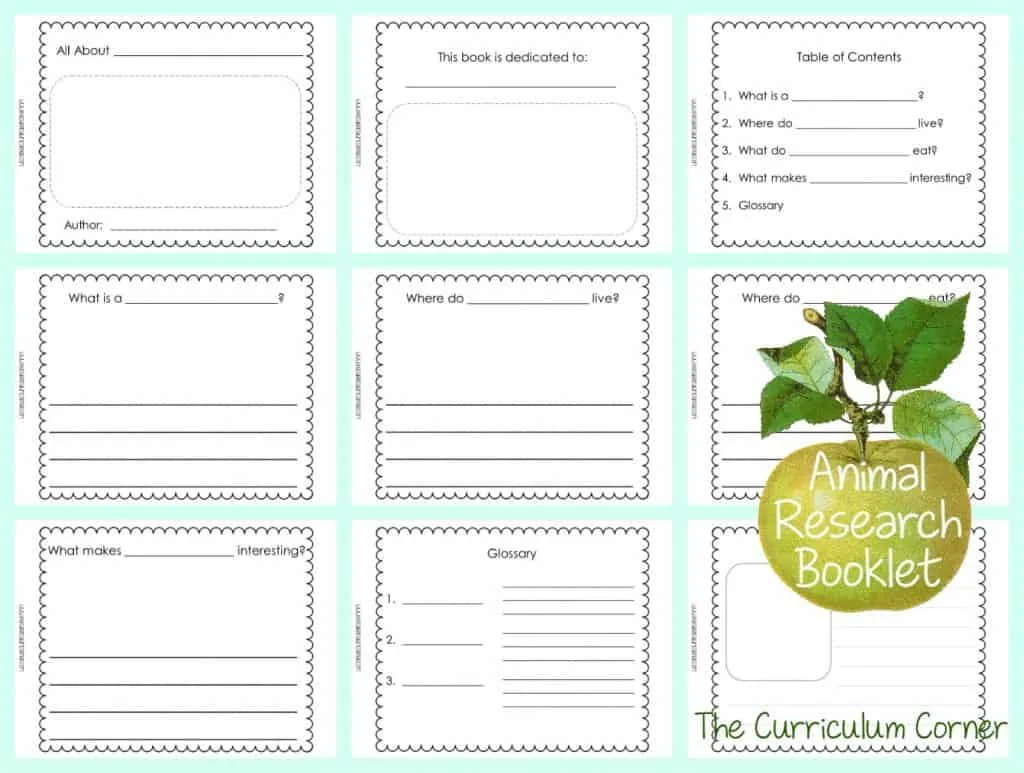
Lesson 12: Labeling Pictures
- One final lesson idea that pairs well with writing informational text is to teach your students how to label pictures.
- Since most nonfiction writing has real photographs, students can find some pictures online to print out and label for their booklet. Hand-drawn pictures are also great if you would rather encourage some or all of your students in that direction.
- Whatever you choose, show your class how to effectively label a picture so that it teaches the reader more. You can use the picture of the polar bear provided to model how to add words or even short facts as labels. (For example if the simple label “fur” wouldn’t add additional information to the book, you might teach them to label it with a short fact such as “dense fur protects the animal’s skin from the weather”.
- To make this idea more user friendly, you might want them to use the page of blank white boxes provided to write their labels for their pictures. Then all they need to do is cut them out and glue them to a printed picture.
Lesson 13: Writing Celebration
As always, find a way to celebrate your students’ writing.
Invite guests (younger students or special adults) to read the books with your young authors. You might simply want to pair or group them, or some students might choose to present their book to everyone.
Provide some light snacks if possible to give it a party atmosphere and pass out the author certificates to each child for his/her hard work.
You can download this free writing unit of study here:
As with all of our resources, The Curriculum Corner creates these for free classroom use. Our products may not be sold. You may print and copy for your personal classroom use. These are also great for home school families!
You may not modify and resell in any form. Please let us know if you have any questions.

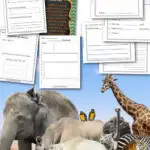
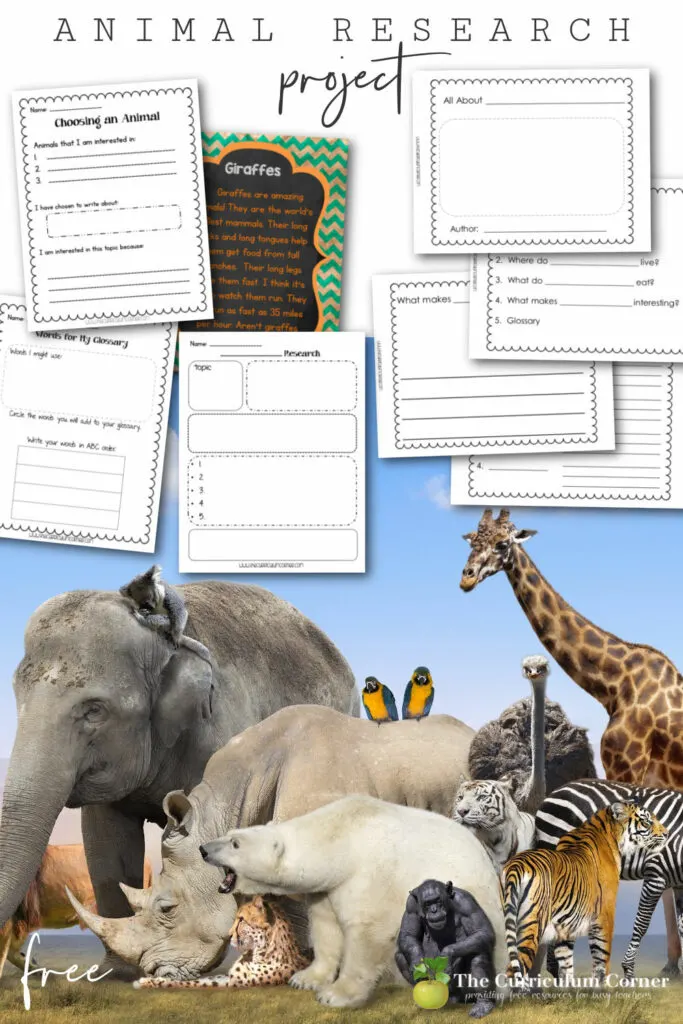
Christine E.
Saturday 8th of May 2021
Thank you so much for this resource and the many pages that I can use in my homeschooling. It is exactly what I've been looking for to help me get my kids to write about our animal units! You are doing a great job, keep up the amazing work you do. I appreciate the hard work you put into putting these together.
Planning a Dynamic Writing Workshop - The Curriculum Corner 123
Saturday 14th of July 2018
[…] Animal Research […]
Editable Writing Management Binder - The Curriculum Corner 123
Friday 3rd of March 2017
[…] Writing Unit of Study: Animal Research […]